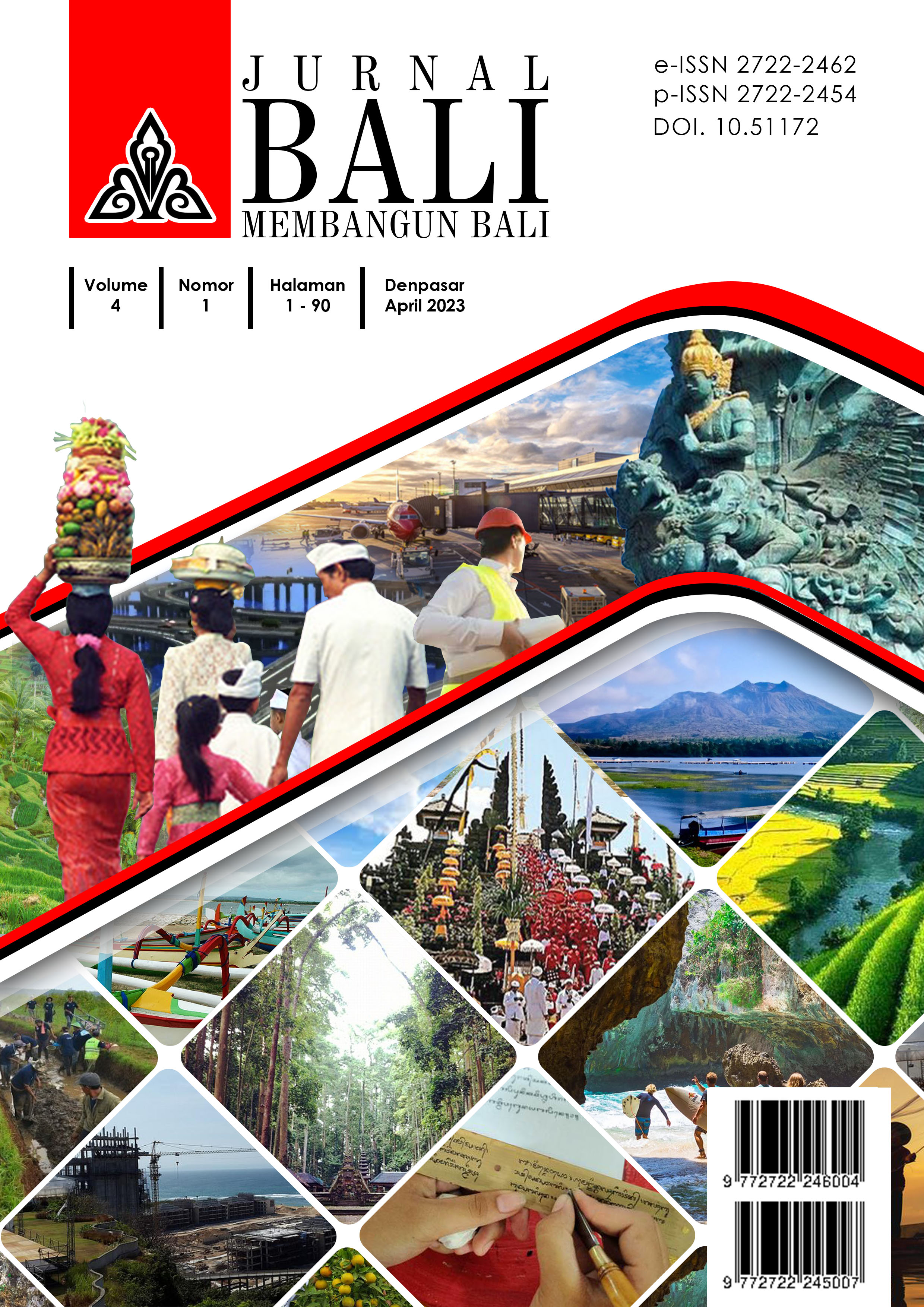Main Article Content
Abstract
Purpose: The purpose of this paper is to analyze the meaning of the Rerajahan form and script which are closely related to Balinese Hindu religious rituals where Rerajahan is one of the cultural assets of the archipelago.
Research method: This study uses a qualitative literary approach which is described in such a way according to the data obtained which in its elaboration contains the process of its meaning.
Results and discussion: Rerajahan is a Balinese Hindu culture as a local genius. Balinese Hindus firmly believe that Rerajahan has magical properties. Rerajahan will be meaningless if it is not filled with inner energy and driven by deep belief as well, then Rerajahan will be an empty image and only contains aesthetics.
Implication: The magical powers that can be elicited by the rerajahan are used for sacred purposes, namely for matters related to Hinduism, which are called Panca Yadnya.
Keywords
Article Details

This work is licensed under a Creative Commons Attribution-NonCommercial-ShareAlike 4.0 International License.
Authors who publish with this journal agree to the following terms:
Authors retain copyright and grant the journal right of first publication with the work simultaneously licensed under a Attribution-NonCommercial-ShareAlike 4.0 International (CC BY-NC-SA 4.0) that allows others to share the work with an acknowledgement of the work's authorship and initial publication in this journal.
Authors are able to enter into separate, additional contractual arrangements for the non-exclusive distribution of the journal's published version of the work (e.g., post it to an institutional repository or publish it in a book), with an acknowledgement of its initial publication in this journal.
Authors are permitted and encouraged to post their work online (e.g., in institutional repositories or on their website) prior to and during the submission process, as it can lead to productive exchanges, as well as earlier and greater citation of published work (See The Effect of Open Access).
References
- Dalem, I G. K. (2012). Fungsi dan Makna Rerajahan dalam Upacara Potong Gigi di Banjar Kutri, Desa Singapadu Tengah, Kecamatan Sukawati, Kabupaten Gianyar. Hasil Penelitian. Denpasar: Institut Hindu Dharma Negeri.
- Darmita, I. P. M. S. D. D. (2011). Filsafat Rsigana. Denpasar: Pos Pustaka Bali.
- Gautama, I W. B. (2007). Kamus Bahasa Bali (BaliIndonesia). Surabaya: Paramita.
- Gunarsa, K. (1993). Gambar, Lambang. Denpasar: CV. Kayu Mas.
- Marhaeni, K. S., Yulianti, N. K. D., & Garwa, I. K. (2022). The values of character education in the pakeliran art “Lord Shiva Saves the Universe”. Journal of Aesthetics, Creativity and Art Management, 1(2), 124–130. https://jurnal2.isi-dps.ac.id/index.php/jacam/article/view/1826; https://doi.org/10.31091/jacam.v1i2.1826.
- Nala, I G. N. & Wiratmadja, I G.K. A. (2012). Murdha Agama Hindu. Jakarta: Dirjen Bimas Hindu.
- Nyoka. (1994). Modre Krakah. Denpasar. Toko Buku Ria.
- Nugraha, G., Adnyana, I. W., & Karja, W. (2022). Iconography of Woman Image in Sri Tanjung Relief at Candi Surowono. Journal of Aesthetics, Creativity and Art Management, 1(1), 1–12. https://jurnal2.isi-dps.ac.id/index.php/jacam/article/view/1591; https://doi.org/10.31091/jacam.v1i1.1591.
- Oka, I. P. S. I., Rai S., I. W., & I Wayan Suharta. (2022). The aesthetics of unity in Kendang Pangarjan performed by I Dewa Nyoman Sura and Cokorda Alit Hendrawan. Journal of Aesthetics, Creativity and Art Management, 1(2), 155–162. https://jurnal2.isi-dps.ac.id/index.php/jacam/article/view/1827; https://doi.org/10.31091/jacam.v1i2.1827.
- Sanjaya, P. P. O. M., Adnyana, I. W., & Muka, I. K. (2022). Tri Hita Karana: A contemporary sculpture creation. Journal of Aesthetics, Creativity and Art Management, 1(2), 95–104. https://jurnal2.isi-dps.ac.id/index.php/jacam/article/view/1847; https://doi.org/10.31091/jacam.v1i2.1847.
- Sudarma, I. P. (2000). Penggunaan dan arti simbolik uang kepeng dalam upacara Ngaben di Desa Adat Suralaga, Tabanan Bali (Doctoral dissertation), Universitas Gadjah Mada.
- Sudarma, I. P. (2015). Rerajahan in Rsi Gana Ritual in Bali. Discovery, 33(147), 56-70.
- Suyatra, P. (2017). Rajah Rangkaian Aksara dan Gambar Berdaya Magis, https://baliexpress.jawapos.com/balinese/21/08/2017/rajah-rangkaian-aksara-dan-gambar-berdaya-magis/ diakses pada tanggal 20 April 2023.
- Tim Penyusun. (2003). Panca Yadnya. Denpasar: (Tanpa Penerbit).
- Watra, I. W., Wandri, N. A., Sukrawati, & Wirawan, G. B. (2008). Ulap-ulap dan rerajahan dalam agama Hindu di Bali. Universitas Hindu Indonesia.
- Yudha, B. (2010). Tinjauan Rerajahan, https://isi-dps.ac.id/tinjauan-tentang-rarajahan/, diakses pada tanggal 20 April 2023.

